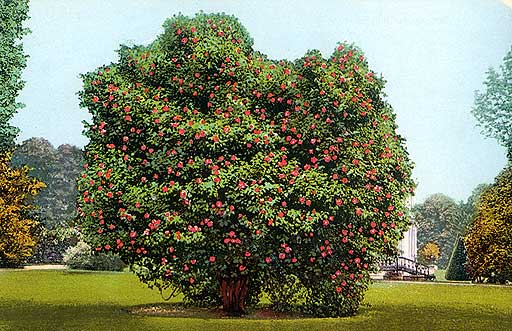Camellia japonica
Common name: Japanese camellia
Family: Theaceae
Leaf: evergreen, oval, leathery glossy, dark green leaves (3-4" long), with finely serrated margin
Flowers: appearing in clusters, 3-5" wide, blooming in mid-late winter (December to March). Species plants have single flowers, but cultivars with semi-double, anemone, peony, rose-form double, or formal double flower forms are available. Each single flower has 5-8 petals. Colours usually are white, pink or red with white anthers. Flowers are borne at the tips of shoots or from lower leaf axils.
Habit: evergreen multi-stemmed shrub; Form: rounded
Height: 5-8': Spread: 3-4'
Culture: This species of camellias comprises of thousands of cultivated varieties. Usually considered to be winter hardy in USDA zones 7-9. However sudden drops in temperature in the winter can damage or kill these camellias. where hardy, should be grown in moist, acidic (5.5-6.5 pH), loose, organically rich, well drained soils in part shade. Consistent and even moisture is important. Does not like wet soils. Needs some protection from direct afternoon sun and wind. Best locations are sun-dappled light shade. Benefits from a mulch. In the colder areas of its growing range, plants should be sited in sheltered and protected microclimates such as near the south side of a home or building. Does not like being transplanted, irregular watering, and dramatic changes in temp. For this reason, burlap wraps are sometimes helpful. If desired, remove all but o of the flowers from each cluster, thus promoting a larger flower. Prune emmediately after flowering. Some cultivars are now temperature rated to USDA zone 6. Susceptible to scale and sooty mold. 'Yuletide' is an attractive cultivar, with strong reddi-ish magenta petals and showy rich yellow stamens.
Uses: Excellent flowering shrub for lawns, shrub borders, backgrounds, informal hedges.
Origin: Eastern and Southern Asia


Habit: evergreen multi-stemmed shrub; Form: rounded
Height: 5-8': Spread: 3-4'
Culture: This species of camellias comprises of thousands of cultivated varieties. Usually considered to be winter hardy in USDA zones 7-9. However sudden drops in temperature in the winter can damage or kill these camellias. where hardy, should be grown in moist, acidic (5.5-6.5 pH), loose, organically rich, well drained soils in part shade. Consistent and even moisture is important. Does not like wet soils. Needs some protection from direct afternoon sun and wind. Best locations are sun-dappled light shade. Benefits from a mulch. In the colder areas of its growing range, plants should be sited in sheltered and protected microclimates such as near the south side of a home or building. Does not like being transplanted, irregular watering, and dramatic changes in temp. For this reason, burlap wraps are sometimes helpful. If desired, remove all but o of the flowers from each cluster, thus promoting a larger flower. Prune emmediately after flowering. Some cultivars are now temperature rated to USDA zone 6. Susceptible to scale and sooty mold. 'Yuletide' is an attractive cultivar, with strong reddi-ish magenta petals and showy rich yellow stamens.
Uses: Excellent flowering shrub for lawns, shrub borders, backgrounds, informal hedges.
Origin: Eastern and Southern Asia

 |
C. japonica 'Roberta Hardison' |

No comments:
Post a Comment